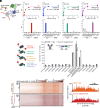Binding mode-guided development of high-performance antibodies targeting site-specific posttranslational modifications
- PMID: 39793060
- PMCID: PMC11725865
- DOI: 10.1073/pnas.2411720121
Binding mode-guided development of high-performance antibodies targeting site-specific posttranslational modifications
Abstract
Posttranslational modifications (PTMs) of proteins play critical roles in regulating many cellular events. Antibodies targeting site-specific PTMs are essential tools for detecting and enriching PTMs at sites of interest. However, fundamental difficulties in molecular recognition of both PTM and surrounding peptide sequence have hindered the efficient generation of highly sequence-specific anti-PTM antibodies. Furthermore, the widespread use of potentially inconsistent, nonrenewable, and molecularly undefined antibodies presents experimental challenges thought to contribute to the reproducibility problem in biomedical research. In this study, we describe the binding mode-guided development of a platform that efficiently generates potent and selective recombinant antibodies to PTMs that are molecularly defined and renewable. Our platform is built on our previous discovery of an unconventional binding mode of anti-PTM antibodies, antigen clasping, where two antigen binding sites cooperatively sandwich a single antigen, creating extensive interactions with the antigen and leading to high selectivity and potency. We designed the platform that generates clasping antibodies with two distinct binding units, resulting in efficient generation of antibodies to a set of trimethylated histone H3 with high levels of specificity and affinity. Performance comparison in chromatin immunoprecipitation, a common application in epigenomics, revealed that a clasping antibody to trimethylated histone H3 at lysine 27 exhibited superior specificity to a widely used conventional antibody and captured symmetric and asymmetric nucleosomes in a less biased manner. We further generated clasping antibodies to phosphotyrosine antigens by using the same principle. These results suggest the broad applicability of our platform to generating high-performance clasping antibodies to diverse PTMs.
Keywords: affinity reagents; epigenetics; histone modifications; protein engineering; signaling.
Conflict of interest statement
Competing interests statement:A.J.R. holds equity in EpiCypher. A.K., S.K., and T.H. are listed as inventors of a pending patent on the technology and antibodies developed in this work filed by New York University. A.K., S.K., and T.H. are inventors of US10208110B2 on recombinant histone PTM antibodies managed by the University of Chicago. A.J.R. is a co-inventor of the ICeChIP technology US10732185B2 managed by the University of Chicago and licensed to EpiCypher. A.J.R. is a scientific advisor at EpiCypher. R.N.S. has received consulting fees from EpiCypher. S.K. is a co-founder, receives consulting fees and holds equity in Aethon Therapeutics; is a co-founder and holds equity in Revalia Bio; has received research funding from Aethon Therapeutics, Argenx BVBA, Black Diamond Therapeutics, and Puretech Health, all outside of the current work.
Figures




Similar articles
-
Antibody tests for identification of current and past infection with SARS-CoV-2.Cochrane Database Syst Rev. 2022 Nov 17;11(11):CD013652. doi: 10.1002/14651858.CD013652.pub2. Cochrane Database Syst Rev. 2022. PMID: 36394900 Free PMC article.
-
High-throughput profiling of histone post-translational modifications and chromatin modifying proteins by reverse phase protein array.J Proteomics. 2022 Jun 30;262:104596. doi: 10.1016/j.jprot.2022.104596. Epub 2022 Apr 27. J Proteomics. 2022. PMID: 35489683 Free PMC article.
-
Systemic pharmacological treatments for chronic plaque psoriasis: a network meta-analysis.Cochrane Database Syst Rev. 2021 Apr 19;4(4):CD011535. doi: 10.1002/14651858.CD011535.pub4. Cochrane Database Syst Rev. 2021. Update in: Cochrane Database Syst Rev. 2022 May 23;5:CD011535. doi: 10.1002/14651858.CD011535.pub5. PMID: 33871055 Free PMC article. Updated.
-
Systemic pharmacological treatments for chronic plaque psoriasis: a network meta-analysis.Cochrane Database Syst Rev. 2017 Dec 22;12(12):CD011535. doi: 10.1002/14651858.CD011535.pub2. Cochrane Database Syst Rev. 2017. Update in: Cochrane Database Syst Rev. 2020 Jan 9;1:CD011535. doi: 10.1002/14651858.CD011535.pub3. PMID: 29271481 Free PMC article. Updated.
-
Magnetic resonance perfusion for differentiating low-grade from high-grade gliomas at first presentation.Cochrane Database Syst Rev. 2018 Jan 22;1(1):CD011551. doi: 10.1002/14651858.CD011551.pub2. Cochrane Database Syst Rev. 2018. PMID: 29357120 Free PMC article.
Cited by
-
A method for the detection and enrichment of endogenous cereblon substrates.bioRxiv [Preprint]. 2025 Mar 26:2025.03.24.645063. doi: 10.1101/2025.03.24.645063. bioRxiv. 2025. Update in: Cell Chem Biol. 2025 Aug 21;32(8):1028-1041.e13. doi: 10.1016/j.chembiol.2025.07.002. PMID: 40196695 Free PMC article. Updated. Preprint.
-
A method for the detection and enrichment of endogenous cereblon substrates.Cell Chem Biol. 2025 Aug 21;32(8):1028-1041.e13. doi: 10.1016/j.chembiol.2025.07.002. Epub 2025 Aug 8. Cell Chem Biol. 2025. PMID: 40782806
References
-
- Strahl B. D., Allis C. D., The language of covalent histone modifications. Nature 403, 41–45 (2000). - PubMed
-
- Olsen J. V., et al. , Global, in vivo, and site-specific phosphorylation dynamics in signaling networks. Cell 127, 635–648 (2006). - PubMed
-
- Hochstrasser M., Ubiquitin-dependent protein degradation. Annu. Rev. Genet. 30, 405–439 (1996). - PubMed
-
- Ohtsubo K., Marth J. D., Glycosylation in cellular mechanisms of health and disease. Cell 126, 855–867 (2006). - PubMed
MeSH terms
Substances
Grants and funding
LinkOut - more resources
Full Text Sources
Miscellaneous

